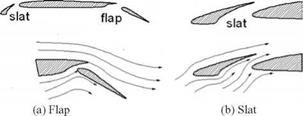Comparison of Three NACA Aerofoils
The NACA 4412, NACA 23015, and NACA 642-415 are three commonly used aerofoils – there are many different types of aircraft that use one of these aerofoils. Figure 3.19 shows their characteristics for comparison purposes.
The NACA 23015 has sharp stalling characteristics; however, it can give a higher sectional lift, C/, and lower sectional moment, Cm, than others. Drag-wise, the NACA 642-415 has a bucket to give the lowest sectional drag. The NACA 4412 is the oldest and, for its time, was the favorite. Of these three examples, the NACA 642415 is the best for gentle stall characteristics and low sectional drag, offsetting the small amount of trim drag due to the relatively higher moment coefficient. Designers
Figure 3.20. Flap and slat flow field (see Figure 3.43 for slat and flap effects)
 must choose from a wide variety of aerofoils or generate one suitable for their purposes.
must choose from a wide variety of aerofoils or generate one suitable for their purposes.
Designers look for the following qualities in the characteristics of a 2D aerofoil:
1. The lift should be as high as possible; this is assessed by the CLmax of the test results.
2. The stalling characteristics should be gradual; the aerofoil should able to maintain some lift past CLmax. Stall characteristics need to be assessed for the application. For example, for ab initio training, it is better to have aircraft with forgiving, gentle stalling characteristics. For aircraft that will be flown by experienced pilots, designers could compromise with gentle stalling characteristics and better performance.
3. There should be a rapid rise in lift; that is, a better lift-curve slope given by dCL/da.
4. There should be low drag using a drag bucket, retaining flow laminarization as much as possible at the design CL (i. e., angle of incidence).
5. Cm characteristics should give nose-down moments for a positively cambered aerofoil. It is preferable to have low Cm to minimize trim drag.
An aerofoil designer must produce a suitable aerofoil that encompasses the best of all five qualities – a difficult compromise to make. Flaps are also an integral part of the design. Flap deflection effectively increases the aerofoil camber to generate more lift. Therefore, a designer also must examine all five qualities at all possible flap and slat deflections.
From this brief discussion, it is apparent that aerofoil design itself is state of the art and is therefore not addressed in this book. However, experimental data on suitable aerofoils are provided in Appendix C.













